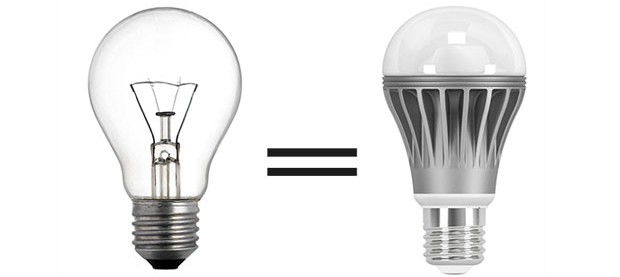In what units is lightness measured - a list of basic
In determining the illuminance you can use different units of measurement. The option is chosen based on the situation. In addition, it is often necessary to translate one indicator into another. It is necessary to take into account in what units the illuminance is measured in order to calculate it correctly, if necessary.
What is illuminance
Under illuminance refers to the light quantity, which is defined as the ratio of the luminous flux to the area of its distribution. This figure is directly proportional to the intensity of the light source from which it comes. With its distance from the surface the illuminance decreases. This relationship is inversely proportional to the square of the distance (law of inverse squares).
The formula for illuminance looks like this: E=(I*cos)/r2. I - is light intensity in candela, r shows the distance from the light source to the surface. This should not be confused with luminance.
In what units is the illuminance measured
The unit of measurement of illuminance is not a single indicator, there are several basic variants accepted in different measurement systems. There is no need to understand complex algorithms and formulas for application. It is enough to learn the peculiarities of each unit and use it correctly, if necessary.
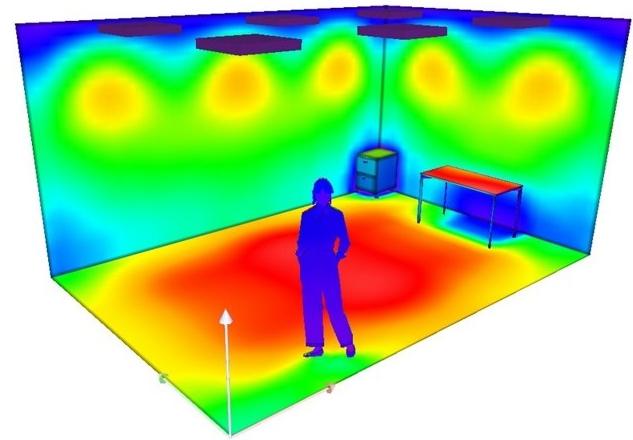
Candela
In the measurement system, one of the seven basic units that are fundamental. It is the intensity of light emitted by a source of monochromatic radiation with a frequency of 540х1012 Hz. Moreover, the light flux must propagate in a given direction under a number of additional conditions.
The frequency used as a reference corresponds to the green part of the spectrum, as it is best perceived by the human eye. Using a light source with a different frequency will require more intensity to achieve the desired value.

Not so long ago, the candela was defined differently. It corresponded to the intensity of the lightcoming from a black source, heated to 2042.5 K (melting platinum), which was perpendicular to the plane and spread out over an area of 1/60th of a square centimeter. This value is used in astronomy and many other sciences.
By the way! The coefficient 1/683used by modern scientists is chosen so that the new and old definitions correspond to each other.
In Latin, "candela" means a candle. The light that one candle emits is said to be equal to 1 candela.
Lumen
Used in the measurement system of physical quantities and reflects the characteristics of light. 1 lumen is luminous fluxwhich is emitted by a light source with a power of 1 candela. To make it easier to understand, it is worth looking at simple examples:
- Standard incandescent bulbs A 100 watt light source has a luminous flux of 1200-1300 lumens.
- A 26 watt fluorescent light source provides a luminous flux of 1600 Lm.
- If we take the sun as an example, its luminous flux is 3.63x1028 lumens.
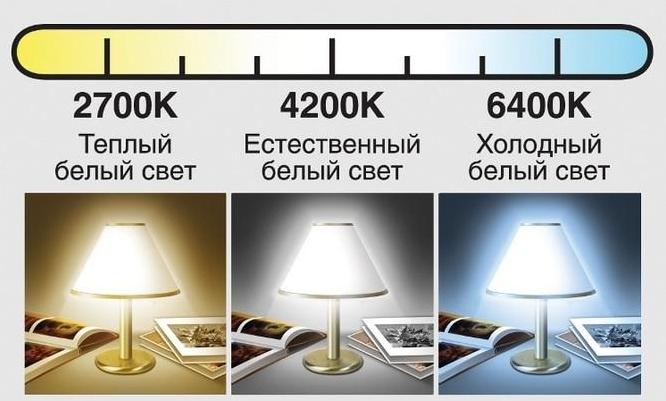
Lumen shows the total luminous flux that comes from a particular source. But it does not take into account important features - the presence of a lens, or reflector, which can concentrate light in a small area and thereby greatly improve illumination. Different lanterns with the same lamp can illuminate 10 square meters as well as 100. In fact, this is all the light that the lamp gives, including the one that does not hit a given surface and is useless.
Keep in mind that a lamp with a wattage of 1500 Lm in a reflector luminaire will provide better conditions than the same option in a diffusing plafond.
If the power exceeds the standard range, special units are used:
- Multiples of lumens are formed when the value is a whole number of times the set value. They are usually denoted as a degree of a number. For naming, established prefixes are used to reflect the magnitude of the value.
- Fractional units of lumens, on the contrary, are less than the set unit by a whole number of times. Special prefixes are also used here, and the degree is indicated with a minus sign.
Lux
This unit is the most useful because it is used to measure illumination in living and working spaces. It is equal to the luminous flux of 1 lumen, distributed over an area of 1 square meter. The indicator is used to regulate various standards and control illumination where required.
For simplicity we can take two examples. If a lamp of 100 Lm is directed to an area of one square meter, the illuminance will be 100 lux. And if the same light source is distributed over 10 square meters, the figure is 10 lux.
The video tells about luminous flux and illuminance (what are the differences, how they are measured)
Lumens and watts
When only incandescent bulbs were sold, watts were used as a reference to determine the luminous flux of a lamp. Everyone knew that the higher the wattage, the brighter the light. But with the advent of other types of bulbs, this characteristic has lost relevance, because it can not be used in determining the performance of equipment. Different variants have a different ratio of power in watts to luminous flux, so it is necessary to understand the main types of equipment:
- Incandescent bulbs have a standard value of 1300 Lm at 100 watts. The 40-watt models will have 400 lumens, and the 60-watt models will have 800 lumens. And remember that over time the brightness will inevitably decrease due to the thinning of the filament, so when calculating it is worth building in a certain reserve.
- Mercury arc lamps have a ratio of 58 Lm per watt, the power is simply multiplied by this figure.
- Fluorescent light sources have a ratio of 60 Lm per watt.
- For LED lamps with a frosted diffuser there is no clear standard, because the characteristics of the bulb and its light transmission can vary. Usually the figure ranges from 80 to 90 Lm.
- Filament (transparent) LED bulbs have a ratio of 100 lumens per watt of power.
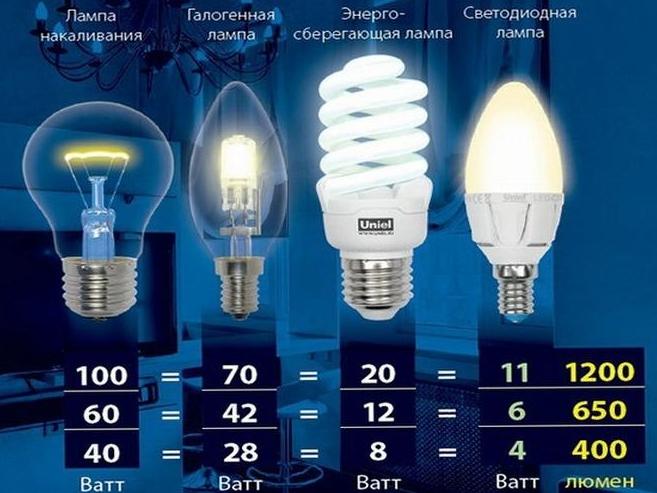
Actual figures may differ from those generally accepted, if the lamp design has features that affect the quality of light.
How to convert one unit of illuminance to another
In the past, complex formulas were used to make calculations; now they are not necessary. The most important thing is to have the value in a certain unit of light at hand so that you can use the raw data.
Next, you just need to find any illuminance converter. You enter the values that are available (you select the appropriate item), and in the second column you set the units of illuminance to which you want to translate. Calculations take seconds and are highly accurate because they are made on the basis of proven formulas.
How to determine the illuminance
With insufficient light, a person is much faster tired, having to constantly strain his eyesight, which is extremely undesirable. Therefore, the SNiP set standards for the main types of rooms, which should be adhered to in determining the necessary lighting.
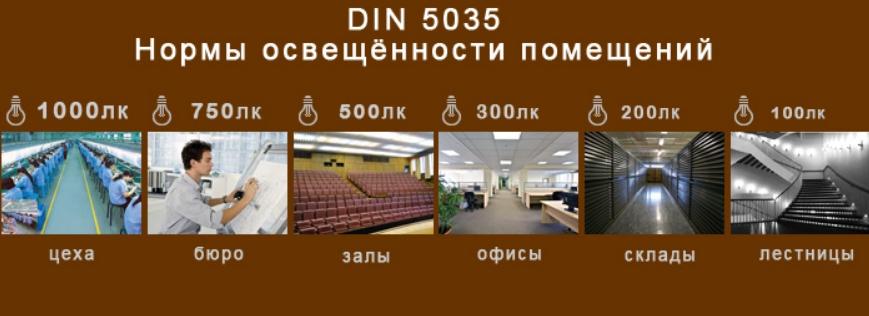
Natural light is taken into account, but the main focus is on artificial light, because it can be used to create optimal conditions regardless of the weather outside. Below are the basic values for different rooms:
- Officesoffices, where people work at computers and prepare documents - 300 lux.
- Drawing rooms - 500 lux.
- Meeting rooms, conference rooms - 200 lux.
- Living and kitchen rooms - 150 lux.
- Children rooms - 200 lux.
- Workrooms Workrooms or zones - 300 lux.
- Classrooms and lecture-rooms - 400 lux.
- Trade halls - from 200 to 400 lux depending on the specifics.
For working areas there are special norms, so there are often used additional lights, which highlight a small part of the space.
As for determining the illumination, a device called a luxmeter is used for this purpose. With its help measurements are taken at several points in the room, they are specified in SNiP, it is important to do everything right. Not only the general indicator can be checked, but also the illumination of a particular surface or equipment, if you need to provide special conditions for the work.
Video on the topic: How to measure the degree of illumination in the room with a smartphone.
Features of determining the brightness for LED devices
This type of equipment enjoys the greatest popularity, so you need to use a few recommendations when choosing equipment and its operation. After the necessary indicators are determined, you should choose specific bulbs or fixtures and calculate the right amount for the room. It is important to distribute them evenly so that there were no poorly lit areas.
Measurements should be taken after the equipment has been in use for at least 2 hours. This is because diodes get hot, which affects their performance characteristics. Repeat the measurements where it is important, 1-2 times a year. Over time, the performance of diodes, especially low-quality diodes, can decrease significantly.
By the way! LED bulbs always have an indication of the power of luminous flux, which simplifies the choice.
To understand the units of measurement of illumination is not difficult, because there are few options. And for practical use, even one will suffice, so it is easiest to choose the appropriate system of measurement and apply it.
